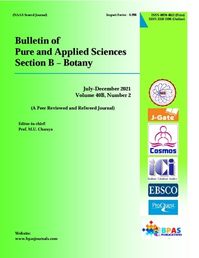Diversity of Zooplankton in the Paddy Fields of Imphal West District
DOI:
https://doi.org/10.48165/Keywords:
Paddy fields, Zooplankton, Imphal WestAbstract
Diversity of zooplankton was studied in three selected paddy fields (PF) of Imphal West District in Manipur namely, Wangoi (PF1), Hiyangthang (PF2), Mayang Imphal (PF3) during August to October, 2020. The study revealed that altogether 55 taxa comprising of 44 rotifera, 8 cladocera and only 3 copepoda (fig2) had occurred in the three studied paddy fields. The highest number of zooplankton taxa (rotifer) was observed at PF1followed by (cladocera) at PF3 and (copepoda) at PF2. Nine physico chemical parameters of water in the three study areas was also analysed The PH value ranged between 6.0 and 8.0, Temperature between 27 and 300C, Dissolved oxygen between 2.0 and 6.0mg/l, Free Carbondioxide between 3.0 and 11.0 mg/l, Chloride between 3.0 and20.0 mg/l, Acidity between 5.0 and 18.0 mg/l, alkalinity between 22.0 and 95.0 mg/l, Nitrate between 0.03 and 0.06mg/l, and Nitrite between 0.01 and 0.05 mg/l. as observed during the investigation period (Table -3).
Downloads
References
Adamczuk, M., Mieczan, T., Tarkowska Kukuryk, M., & Demetraki-Paleolog, A. (2015). Rotatoria –Cladocera – Copepoda relations in the long – term monitoring of water quality in lakes with trophic variation (E. Poland). Environmental Earth Sciences 73 (12), 8189-8196.
Ahlstrom, E.H. (1940). A revision of the rotatorian genera Branchionus and Platyias with varieties. Bulletin of the American Musium of Natural History, 77, 143-184.
APHA, (2012). Standard Methods for the Examination of Water and Waste water, 22nd ed. American Public Health Association, New York, USA.
Carpenter, S.R., & Kitchell, J.F (1996). The trophic cascade in lakes. Cambridge University Press. New York, USA.
Dodson, S.I., Everhart, W.R. Jaldl, A.K., &Kranskopf, S.J. (2007). Effect of watershed land use and lake age on Zooplankton species richness. Hydrobiologia, 579 (1), 393- 399. DOl: 10.1007/S 10750-006-0392-9
Iturburu, F.G., Calderon, G., Ame, M.V., & Minou, M.L. (2019). Ecological Risk Assessment (ERA) of pesticides from fresh water ecosystems in the Pamp as region of Argentina. Legacy and current use chemical contribution. Science of the Total Environment, 691, 476-482. DOI: 10.1016/ J. Scitolenv. 2019. 07. 044.
Jernberg, S., Lehtiniemi, M., & Uusitalo, L. (2017). Evaluating zooplankton indicators using signal detection theory. Ecological indicators, 77, 14-22. DOI. 10. 1016/ J. ECOLIND. 2017.01.038
Koste, W., & Sheil, R. (1989). Rotifera from Australian inland waters IV Colurellidae (Rotifera: Monogononta) Transections of the Royal Society of South Australia, 113 (3), 119- 143 pp.
Lim, R.P., Abdullah, M.F., & Fernando, C. (1984). Ecological Studies of Cladocera in the ricefield of Tanjung Karang, Malaysia, Subjected to pesticide treatment. Hydrobiologia113, 99-113pp.
Lopretto, E.C., & Tell, G. (1995). Ecosistemas de aguascontenentales Edicisnes sur La Plata. Argentina.
Paggi, J.C (1995). Cladocera, In E. Lopretto& G. Tell (Eds.), Ecosistemas deaguascontennentales. Ediciones Sur. La Plata Argentina.
Regaldo, L., Gutierrez, M.F., Reno, U., Fernandez, V, Gervasio, S., Repetti, M.R., & Gagneten, A.M. (2018). water and sediment quality assessment in the colastine – corrolito stream system (Santa Fe, Argentina): impact of industry and agriculture on aquatic ecosystems. Environmental Science Pollution Research, 25(7), 6951-6968.
Ringuelet, R.A. (1958). Los Crustaceos Copepods de las aquascontenentalesten la Republica Argentina. Universidad de Buenos Aires, Facultad de Ciencias Exactas Naturales. Contribuciones Cientificas. Serie Zoologic, 1(2).
Stadlinger, N. Berg, H., Van den Brink, P.J., Tam, N.T., & Gunnarsson, J.S. (2018). Comparision of predicted aquatic risks of pesticides used under different rice farming strategies in the Mekong Delta, Vietnam, Environmental Science Pollution Research, 25 (14), 13322-13334.
Ueno, T. (2013). Bio indicators of biodiversity and farming practice rice paddies. International Journal of Chemical Environmental & Biological Science 1(1), 84-87.
